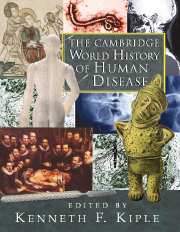Book contents
- Frontmatter
- Introduction
- Part I Medicine and Disease: An Overview
- I.1 History of Western Medicine from Hippocrates to Germ Theory
- I.2 History of Chinese Medicine
- I.3 Islamic and Indian Medicine
- I.4 Disease, Human Migration, and History
- Part II Changing Concepts of Health and Disease
- Part III Medical Specialties and Disease Prevention
- Part IV Measuring Health
- Part V The History of Human Disease in the World Outside Asia
- Part VI The History of Human Disease in Asia
- Part VII The Geography of Human Disease
- Part VIII Major Human Diseases Past and Present
- Indexes
- References
I.2 - History of Chinese Medicine
from Part I - Medicine and Disease: An Overview
Published online by Cambridge University Press: 28 March 2008
- Frontmatter
- Introduction
- Part I Medicine and Disease: An Overview
- I.1 History of Western Medicine from Hippocrates to Germ Theory
- I.2 History of Chinese Medicine
- I.3 Islamic and Indian Medicine
- I.4 Disease, Human Migration, and History
- Part II Changing Concepts of Health and Disease
- Part III Medical Specialties and Disease Prevention
- Part IV Measuring Health
- Part V The History of Human Disease in the World Outside Asia
- Part VI The History of Human Disease in Asia
- Part VII The Geography of Human Disease
- Part VIII Major Human Diseases Past and Present
- Indexes
- References
Summary
Premedical Health Care
A concern with illness has been documented in China for three millennia; the earliest written evidence extant today on the theoretical and practical consequences of this concern dates from approximately the eleventh century B.C. At that time, and for centuries to come, it was assumed that the well-being of the living – be it related to success on the battlefield, to an abundant harvest, or to physical health – depended to a considerable extent on their interactions with the nonliving members of the community (i.e., with their ancestors). An adherence to specific norms was thought to guarantee social and individual health; transgressions were known to cause the wrath of the dead, who then had to be propitiated with sacrifices. The communication between the living and the nonliving that was necessary to establish the cause of an affliction and to identify an appropriate remedy was recorded on bones and turtle shells, many of which were found in the soil, especially in the province of Henan, earlier this century. Whether the belief in ancestral intervention was supplemented by a pragmatic application of drugs or other empirically valuable means of therapy was not documented in written form at this early time.
Political changes during the first millennium B.C., when the Chou dynasty fell into a period of turmoil with several centuries of civil war, may have been responsible for the rise of a new worldview. Even though a belief in the effect of ancestral curses or blessings on the health of the living has survived in Chinese culture well into the twentieth century, especially among some rural strata of the population, Chou sources indicate a change in emphasis.
- Type
- Chapter
- Information
- The Cambridge World History of Human Disease , pp. 20 - 27Publisher: Cambridge University PressPrint publication year: 1993
References
Accessibility information
- 2
- Cited by

